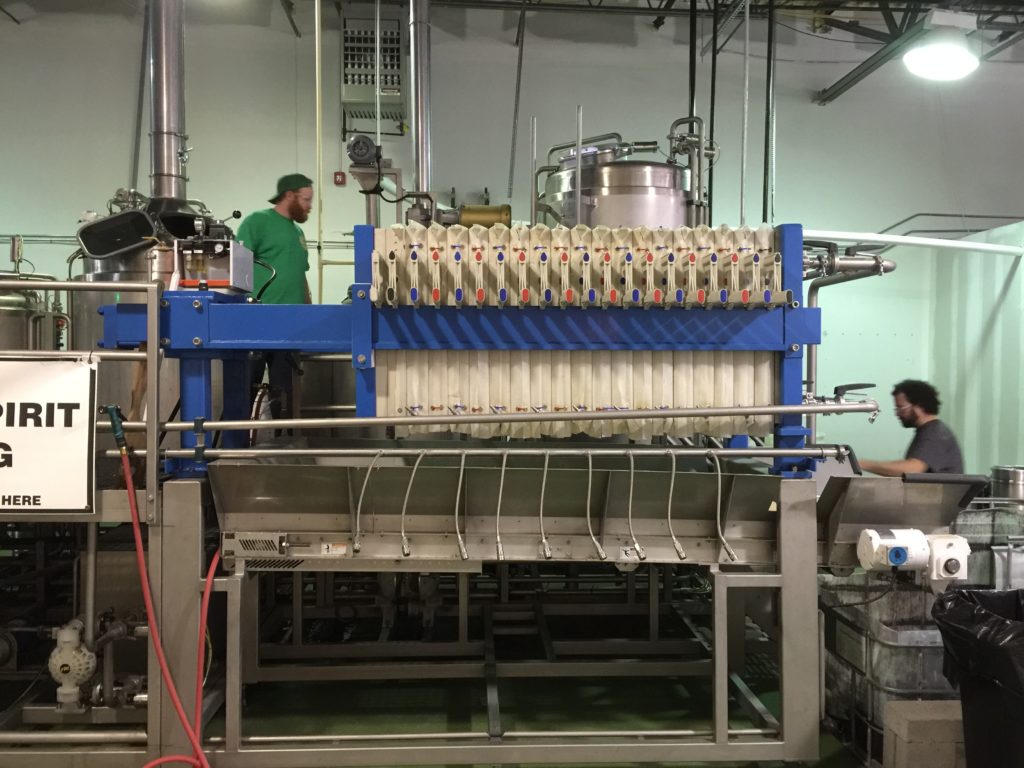
It first started when I visited Calvert Brewing Company in Maryland. What was that device attached to the brewhouse? Then I saw it again in Washington, DC, at Hellbender Brewing Company. On a visit to Nashville Brew Works in Tennessee, there it was once more. And finally, close to home, at the newly opened Kindred Spirit Brewing – another one. The mash filter. What is it and why am I seeing more and more of them?
To understand how a mash filter works, we need to understand lautering. Lautering is simply the process of separating the sweet wort from the mash. This process most commonly is done in a lauter tun. Some breweries have a combined mash mixer/lauter tun to save space. The lauter tun is simply a vessel designed with a false bottom so that the sweet wort can be drained to the kettle while leaving the grain behind. This draining process is preceded by a gentle recirculating of the wort back into the lauter tun, helping to clarify the wort by using the grain bed as a natural filter. While the wort is being run-off into the kettle, hot water is gently added to the grain bed to extract as much of the sugars from the grain as possible, thus increasing the yield in the kettle.

So why use a mash filter and not the more traditional lauter tun? In the words of Kindred Spirit Brewing’s Head Brewer Lee Lonnes – “less malt, less water and more yield.” And therefore, less environmental impact. In many ways, the mash filter looks a lot like a plate and frame filter. Using compressed air, the filter is pushed closed and the mash is pumped from the mash mixer to the mash filter. After a short recirculation (Vorlauf), the wort is run-off from the filter to the kettle. Every other chamber on the mash filter has been fitted with a bladder. Water is pumped into the bladders at high pressure, thus squeezing the mash. Sparge water is added as well, similar to traditional lauter tun brewing. By squeezing the mash, less water is left behind in the mash, and more wort is extracted to the kettle. Efficiencies for mash filters typically run in percentages from mid-to-high 90s. And the spent grain going to Kindred Spirit’s local farmer looked extremely dry.
There are a few other points that Lee brought up. Depending on the size of the mash, he can add or remove plates from the filter. So it has flexibility, unlike traditional lauter tuns. He also uses a much finer grind on his mill, almost making a powder, which increases the yield. Finally, with a mash filter, there is no worry of having a stuck mash. Wheat and rye and other adjuncts can be used at much higher rates without gumming up the lauter tun.

So what’s the catch? Well, they are significantly more expensive than traditional brewhouse technology. They are also relatively new to the US market. But they are widely used and accepted throughout the rest of the world.
The Kindred Spirit mash filter was manufactured by IDD in San Diego. There is also a Belgian company, Meura, that makes mash filters as well. As more and more breweries look at efficiencies and return-on-investment, I imagine IDD and Meura will be quite busy moving forward.



